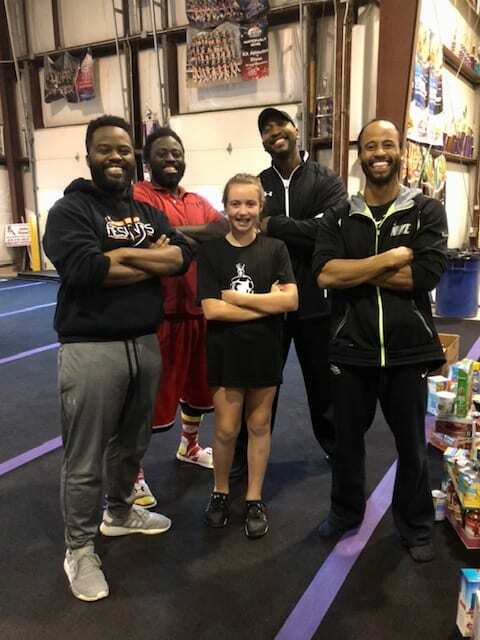- Health Is Wealth
- Posts
- All Star Cheer Costs a Fortune, but I Pay for It Anyway. Here’s Why
All Star Cheer Costs a Fortune, but I Pay for It Anyway. Here’s Why
I’m a pretty frugal person by nature.
I use coupons when I remember them, mostly keep to a budget, occasionally participate in no-spend challenges, and have an overall handle on what I’m doing with my money.
Plus, there’s not a whole lot I like to spend money on. Food allergies keep me eating at home, the library has all the books I need, and I’m not interested in fashion.
However, there are a few exceptions: pens, notebooks, lip balm, and all star cheerleading.
For the past seven years, my daughter has been a competitive cheerleader. I don’t want to add up all the money I’ve spent on it because, well, it’s a lot. But even though all star cheer takes up a significant part of my monthly budget, when I sit down and think about it, it’s worth it.
Why Does It Cost So Much?

There’s no one answer to why cheerleading is so expensive, but there are some explanations. You have to pay for uniforms, bows, shoes, travel, tuition, competition fees, practice gear…the list goes on. And that’s just what you’re paying the gym.
Don’t forget about personal expenses, like hair ties, bobby pins, hairspray, makeup, and gas driving to all the places.
There’s also optional stuff like cheer camp, tumbling classes, private lessons, and more. It’s not much taken separately, but it’s a lot when you put it all together. Over the years, I’ve spent anywhere from $5,000-$10,000 in a single full-year season. And there are plenty of parents who spend significantly more than that (although there are some who spend less).
Another reason, and one that’s been talked about at length in the cheer community, is that one company essentially has a monopoly on all star cheer. If you watched Cheer on Netflix, you saw the parents and friends of the Navarro athletes complaining that they couldn’t watch the Daytona competition without paying for it. And that’s completely true.
Thanks to Varsity’s stranglehold on the competitive cheer world, you can’t do anything without paying a fortune. Almost nothing is free, including watching your athlete perform. Because there’s no competition to force them to lower their prices, they can effectively do whatever they want. And they do.
The gyms have to pay, which means the families have to pay.
Related: How to Make a Budget in 7 Easy Steps
There Are Ways to Make Cheer More Affordable
Until some things change, I’ve accepted that this is an expensive sport. Complaining about the cost isn’t going to make the price go down, but there are ways I mitigate it.

Budget. Knowing how much I have to pay each month and putting it as a line item in my budget means I have the money available when I need it. I break it down into tuition, fees, clothes, tumbling, extras, one-day competitions, and two-day competitions. I also make sure to account for end-of-season competitions and start saving for those as soon as each new season begins.
Participate in fundraisers. This isn’t something I take advantage of as much as I should, but the fundraisers do help offset some of the costs.
Be creative. I look for all the possible ways you can save money. For instance, we carpool for practice. I’ve bought used uniforms, paid competition fees in full early to take advantage of pre-payment discounts, used coupons and sales to buy things like socks or hairspray. I’ve shared rooms when I travel and pack snacks and water for inside the venues. There are fees I can’t do anything about, but with a little creativity, I can control some of the costs.
Know my limits. Because I set such a strict budget, I know what extras I can and can’t afford, and I stick to that. I also know that if cheer does become a financial burden, I can do things like move her to a less-costly rec program, stop extra tumbling lessons, or talk to our gym owner about scholarships and sponsorships.
And, of course, there’s always the hope that she gets a paid bid to whatever end-of-season competition we attend. That’s a huge money-saver!
Five Reasons I Pay for All Star Cheer Anyway
Even with the money-saving strategies I employ, it’s still costly. But as long as I can afford it, I’m going to continue to pay for all star cheerleading.
My daughter loves it

To say my child is obsessed with cheerleading is an understatement. She follows cheer the way football or baseball players follow their sport. She knows the rules, the teams (especially the Worlds-level teams), and the cheerlebrities. She’s learning the history of it. She and her best friend even have Cheerleading Worlds pools the way other people have Super Bowl pools.
Not only does she love the sport, but she loves participating in it. Her entire face and demeanor change when she gets to the gym, when she’s talking about competing or her dream of cheering in college, and the excitement when she learns a new stunt or tumbling skill. As a parent, it’s hard to ask for more than that.
The gym is her happy place, her teammates are some of her closest friends, she’s free to be herself, and all of that alone is worth the price.
Soft skills

Developing skills like responsibility, time management, self-confidence, and problem-solving isn’t unique to cheerleading. I think most sports teach them. But with cheerleading, athletes need to learn how to balance homework with practice and conditioning with chores, and how to stand up for themselves when people make fun of you for being a cheerleader.
Those comments teach her patience, tolerance, and self-control. Detention is not an option because someone doesn’t think cheerleading is a sport.
But what they’re really learning is all the skills it takes to function at work, at home, and in society. And they truly do transcend the mat. “I think cheer helps me with group projects in school,” my daughter said. “You have to trust people to do their jobs and you have to learn to work with people you might not get along with.”
It keeps her busy
My daughter is in the gym for roughly six hours each week, more when she’s doing her tumbling program. When the weather is nice, she has to run a mile every week. She also needs to condition. Between what’s required of her from cheer and school (and music lessons), there’s not a whole lot of downtime.
Don’t get me wrong. She still has plenty of time to see her friends, scroll mindlessly through Instagram, and get all of her homework done, but boredom and my daughter don’t mix. Cheer is a way to keep her physically active, off of her phone, and out of trouble.
Relationships

There’s a stereotype that cheerleaders are mean, catty, rude, and overall awful. It makes me furious when I hear that. Mean girls are everywhere, not just in cheer, despite what movies and TV want you to believe.
In our experience, some of the kindest, friendliest, and most accepting kids we’ve met, and some of my daughter’s closest friends, have come into our lives as a result of cheerleading.
These are friends she FaceTimes every single day, even when they’re planning on seeing each other in 20 minutes. These are friends who know her better than anyone, who she can count on, and who she feels completely safe and comfortable around. She can cry to them, laugh with them, and talk to them about anything.
She also participates in a tumbling program with athletes from multiple gyms who perform at varying skill levels. The nicest thing about this program is that everyone is incredibly supportive, encouraging, and it really feels like a family. These are friends who genuinely get excited for her when her team wins or she learns a new tumbling pass.
Jealousy isn’t a part of these friendships, and that’s hard to find. Since they go to different schools or live in different states, she has to work to maintain these friendships. I like that she’s learning that relationships take effort to maintain and nurture. It’s not something that everyone understands.
Her coaches

I believe that all kids need adults in their lives (besides their parents) who encourage, push, and support them. They need adults who look out for their physical and mental well-being and who have a stake in their successes and failures. These adults can come in the form of rabbis, pastors, teachers, grandparents, or neighbors.
For my daughter, those adults are her coaches. We’ve been fortunate enough to have an incredible set of coaches, especially these last two seasons, who love what they do, genuinely care about the kids on and off the mat, and have stood by her through some of the worst moments of her life. For that, I am immensely grateful.
Having coaches who believe in her and are there for her is absolutely priceless.
There’s Something In It for Me, Too
I could go on and keep talking about all the things my daughter gets out of cheer: good sportsmanship, discipline, structure, routine, and so much else. It’s been a complete asset to her life. But between us, I get something out of it, too.
I don’t just mean the ability to curl hair or get glitter off of anything or wash and dry a uniform with a moment’s notice. Or the fact that the business of cheerleading is absolutely fascinating or that I can pull bobby pins out of anywhere or even that I know my way around the greater Baltimore area better than I ever thought I would.
What I get out of being a cheer mom is that it gets me out of the house and socializing with other adults.
I am a pretty serious introvert who prefers reading books and watching true crime documentaries on Netflix. On top of that, I work exclusively from home. I can have groceries delivered, work out in my living room, and my dogs are perfectly content playing in the backyard. There’s no need for me to ever leave my house or even talk to people face-to-face.
In the winter, that’s actually preferable. Pretty ideal, in fact.
However, cheerleading is a winter sport. I have to leave my house. My daughter has practice, competitions, clinics, and various other cheer-related activities she needs to attend. Someone has to take her to those things. That someone is me.
So I use that time to talk to other parents. For someone like me, who’s pretty shy and awkward, having common ground makes it easier to start or stay involved in conversations. We’re all there at some ungodly hour sitting in uncomfortable seats listening to loud music for the same reason — to support our kids.
Being a cheer mom is like being in a sparkly sorority with a secret language that only other cheer parents understand. Instead of a handshake, we have bows and cheer hair and our hearts pound like crazy for two minutes and thirty seconds while our athletes compete. We all gasp when flyers fall, scream when our kids hit zero, and think the tiny and mini teams are just the cutest things ever.
If you’re lucky, like I’ve been, you find parents you can talk with about things other than cheer and you consider them friends.
It’s Not Perfect But It’s Ours
Please don’t misunderstand. All star cheerleading is by no means perfect. Some people feel that it’s just not worth it. It’s cost-prohibitive for many families. Parents can be mean, spiteful, hostile, and uber-competitive, oftentimes worse than the kids. You won’t always fit in at your gym and might end up feeling like an outsider.
It’s incredibly time-consuming, athletes get hurt, teams lose, and you definitely go over budget more often than you’d probably prefer. Social media can make you feel all kinds of emotions, especially when there’s gossip, bullying, or any other drama.
And driving two hours to sit in a convention center for hours at a competition that feels like it’ll never end because they’re always running late while paying $6 for a bottle of water and $20 in spectator fees is not most people’s first choice for spending a Saturday.
But we do it for our kids. We do it because we know how they beam when they hit, glow when they win, and how different they’d be without cheer. We do it because we know how much it means to them.
You can’t make a budget line item for that.
The post All Star Cheer Costs a Fortune, but I Pay for It Anyway. Here’s Why appeared first on DollarSprout.